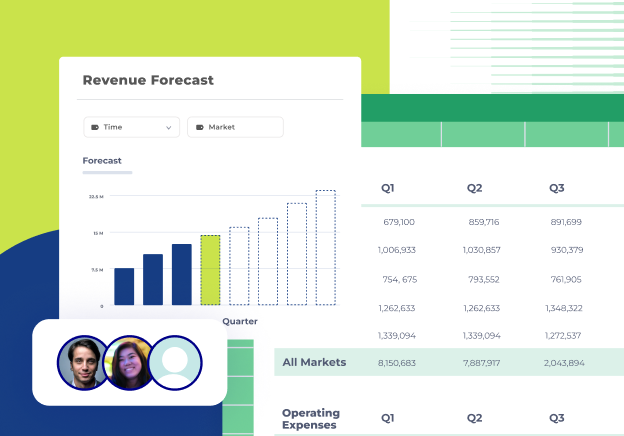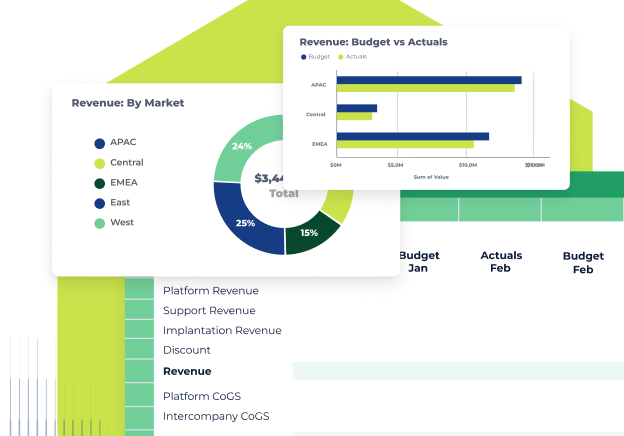Why is strategic planning so important for businesses?
Strategic planning provides a structured approach to setting goals, allocating resources, and measuring success. It connects financial planning and budgeting to broader company objectives, ensuring that budgets don’t just manage costs but actively support growth initiatives, risk management, and operational resilience.
Without a solid strategic plan, businesses risk reactive decision-making, misallocating capital, and operating in silos. But done right, a well-defined strategic plan improves forecasting, strengthens performance, and builds stakeholder confidence.
The critical alignment between finance and strategy
Finance leaders who bridge strategic finance and business strategy drive profitability, operational efficiency, and informed decision-making. Without that alignment, strategies can fall apart due to poor resource allocation or unrealistic goals.
Here’s how finance keeps strategy grounded, actionable, and agile:
- Shapes strategy with data: Finance teams use revenue patterns, forecasts, and constraints to inform strategic plans. These insights help leaders prioritize, assess opportunities, and set realistic, financially sound objectives.
- Turns strategy into action: Budgets, forecasts, and capital plans bring high-level goals to life. Finance ensures the organization has the resources—and guardrails—it needs to execute effectively.
- Keeps execution on track: Through regular reporting and variance analysis, finance teams spot inefficiencies early and make real-time adjustments to stay aligned with business goals.
- Supports agility: Scenario planning and frequent reviews allow teams to pivot quickly when conditions change, without losing sight of long-term financial health.
- Connects teams with a shared view: Integrating financial and operational data enables faster, more confident decisions across departments and leadership.
When finance and strategy move in lockstep, teams can move from tactical support to strategic leadership, whereby every decision supports smarter growth and long-term sustainability.
Want to assess how well your finance function supports strategic growth? Take this free Strategic Finance Assessment.

How to develop a financial plan that supports your business strategy
A well-prepared financial plan provides a roadmap for achieving strategic alignment across departments. Every allocation of resources should reflect priorities that drive long-term success.
Here’s how to get started.
Define financial objectives and KPIs and set goals
Setting clear financial objectives and identifying key performance indicators (KPIs) ensures that every goal is measurable and aligned with the organization’s priorities. Objectives should focus on areas such as revenue growth, profitability, and operational efficiency, while KPIs provide a framework for tracking progress and making data-driven adjustments when required.
Here are some typical KPIs finance leaders can use to measure organizational health:
- Gross profit margin: Measures how efficiently a company generates profit after accounting for the cost of goods sold.
- Operating expenses ratio (OER): Assesses how much of the company’s revenue is spent on operating costs, helping to monitor efficiency.
- Current ratio: Evaluates a company’s ability to meet short-term obligations by comparing current assets to current liabilities.
- Return on equity (ROE): Indicates how effectively a company generates profits from shareholders’ equity.
- Cash conversion cycle: Tracks how quickly a business can turn inventory investments into cash flow from sales.
- Employee retention rate: Measures workforce stability and helps gauge how well the organization is supporting and retaining its people.
- Customer acquisition cost (CAC): Calculates the total cost of acquiring a new customer, reflecting marketing and sales efficiency.
Revenue goals can be a response to specific sales targets or market expansion plans, while expense-related KPIs might focus on cost reduction in non-essential areas. Similarly, cash flow metrics help maintain liquidity and ensure operational stability.
Use this free financial KPI dashboard template to simplify tracking and reporting.

Set up a timeline
Effective timelines ensure financial planning processes remain organized and efficient, serving as a solid foundation for mapping this year’s finance strategy. Defining deadlines for budgeting, forecasting, and performance reviews helps teams stay on track and maintain data accuracy. Structured timelines also prevent errors that could disrupt decision-making.
To get you started, here are some of the most common milestones that shape the financial planning process:
- Budgeting kick-off: A specific date to begin the budgeting process, with enough flexibility to allow time for data gathering, discussions, and revisions.
- Forecasting checkpoints: Schedule monthly or quarterly forecast updates to reflect changing business conditions and priorities.
- Major expense dates: Flag key dates for large vendor payments, lease renewals, or planned capital expenditures.
- Reporting deadlines: Define due dates for monthly, quarterly, and annual financial reports to keep analysis on schedule.
- Mid-year check: Assess progress halfway through the fiscal year to evaluate financial health and make course corrections.
- Year-end analysis: Conduct a comprehensive review at year-end to inform planning for the next fiscal cycle.
- Departmental budget submissions: Set a clear submission window for teams to finalize and submit their budgets ahead of major planning phases.
Using a planning calendar keeps processes streamlined and informs all stakeholders of key dates and deliverables.
Download this free financial planning calendar to set a clear cadence for your financial strategy from kickoff through year-end.
Develop comprehensive content for each part of the plan
Once you've outlined your objectives and timeline, it's time to build out the core components of your financial plan—starting with the budget.
Budgets
Budgets are a financial blueprint for your organization and translate strategic priorities into actionable spending plans. In a strong budget, you’ll outline expected revenue, allocate resources across departments, and set spending limits based on business goals. It should distinguish between fixed and variable expenses, account for seasonality, and reflect both short-term operations and long-term investments.
Modern financial management tools simplify the budgeting process by pulling real-time data from enterprise resource planning (ERP) systems, human resources (HR) apps, and bookkeeping tools, which improves accuracy and reduces manual input. You can also benefit from version control and what-if analysis to test assumptions and refine allocations before finalizing budgets.
Forecasts
Forecasts are forward-looking estimates that help teams anticipate performance and stay ahead of changing conditions. Unlike static budgets, forecasting models are dynamic and should be updated regularly to reflect the latest internal and external data. This allows organizations to make timely adjustments when revenue projections shift or expenses rise unexpectedly.
Effective forecasting includes multiple scenarios—baseline, optimistic, and conservative—and focuses on key drivers like revenue growth, customer churn, and margin changes. Real-time access to financial and operational metrics improves forecasting accuracy, while advanced analytics reveal patterns and highlight opportunities.
Integrated financial planning software allows finance leaders to generate rolling forecasts that update automatically, enabling agile decision-making and tighter alignment with business strategy.
Models
Financial models allow finance teams to simulate various business scenarios and evaluate the impact of decisions before implementation. Models should include detailed revenue forecasting, cost analysis, and investment planning.
Revenue models, for instance, can forecast income based on historical trends, pricing strategies, or market conditions, while cost models help identify areas where resources can be better allocated to support growth.
Scenario analysis is especially valuable for anticipating potential risks or opportunities and preparing for different outcomes. Looking into a range of possibilities, from best-case growth to worst-case disruptions, allows you to stress-test assumptions and evaluate how decisions hold up under pressure. This helps uncover vulnerabilities, estimate financial impact, and identify mechanisms for adjustment before risks materialize.
Scenario planning, combined with contingency measures, helps businesses navigate uncertainties while staying focused on their objectives. It empowers teams to build flexible action plans for adjusting headcount, reallocating capital, or delaying investments in advance, so you can pivot quickly when conditions change. Scenario analysis shifts finance from reactive to proactive, which leads to faster, more confident decisions, even in volatile environments.
Present your plan to stakeholders and get company buy-in
Communication plays a central role in securing alignment among stakeholders. Financial plans should not only convey key data but also demonstrate how they support the organization’s strategic goals. Presenting complex information in a clear and concise manner ensures that both financial and non-financial stakeholders can understand and engage with the plan.
Using visual tools, such as charts or dashboards, highlights key insights and trends. Connecting financial goals to specific business priorities builds trust and fosters collaboration across teams. Collaborating with department leaders to define clear financial targets helps establish accountability and prioritize initiatives that deliver measurable value.
Before presenting the final plan, conduct an internal review of the planning calendar with trusted team members, then seek feedback or approval from senior leadership and other key stakeholders. Gathering and implementing a variety of perspectives keeps you aligned with your objectives across the board and gets full organizational buy-in for your calendar.
Monitor your plan
Regular monitoring ensures that financial plans remain aligned with changing business conditions. Tracking performance against objectives helps finance leaders identify areas for improvement and make timely adjustments. For instance, analyzing variances between actual results and projections can uncover inefficiencies or highlight opportunities for growth.
Plus, static budgets and plans can fall short in dynamic markets. Economic shifts, regulatory changes, or performance variances demand flexibility in planning. Finance teams should:
- Regularly update forecasts to reflect changes in business conditions or priorities.
- Use real-time analytics to identify trends and adjust plans accordingly.
- Incorporate contingency planning to prepare for unexpected disruptions.
- Stay informed about industry trends and economic and market changes.
- Conduct detailed scenario modeling and contingency planning to navigate any shifts.
Resilient finance departments anticipate risks and maintain flexibility to adapt when challenges arise. Finance teams should continuously refine plans to reflect new challenges or opportunities, ensuring strategies remain relevant and effective while identifying opportunities for growth.
To get a head start on your financial planning, download Cube’s ready-made calendar template.

Mistakes and pitfalls to avoid when building a strategic financial plan
A clear financial plan demands precision, alignment, and adaptability. Addressing potential pitfalls ensures that financial planning becomes a solid foundation for business success.
Weak data foundation and inconsistent reporting
Accurate data is the backbone of any financial plan. Poor data management, inconsistent reporting, or outdated information leaves decision-makers with unreliable insights. These data gaps can cascade into flawed forecasts, missed targets, and inefficient use of resources.
To avoid this, standardize how you collect and report financial data across departments, and you’ll generate greater consistency and clarity in every financial statement. Real-time reporting tools improve visibility into current performance and enable you to make quicker course corrections. Regularly auditing data sources gives you even more accuracy and cuts out errors before they compound.
Misalignment between budgets and business priorities
Budgets that fail to reflect broader business goals lead to wasted resources and missed opportunities. Strategic objectives often go unsupported when financial planning operates in isolation from corporate planning. To remedy the situation, you should:
- Synchronize financial planning sessions with strategic goal-setting discussions to ensure alignment.
- Collaborate with department leaders to identify how budgets can drive critical initiatives.
- Use detailed scenario planning to test how financial decisions impact long-term goals.
Overlooking cash flow management
Strong revenue projections can be deceptive if cash flow isn’t carefully monitored. Even profitable companies can face liquidity issues if they fail to manage working capital effectively. Without a clear view of cash availability, businesses may experience operational disruptions or miss key opportunities for growth.
However, developing rolling forecasts allows teams to track cash flow over time and respond to shifts proactively. Optimizing payment terms and improving working capital efficiency can strengthen liquidity, while stress testing prepares teams for potential shortfalls under different economic scenarios.
Lack of collaboration across departments
Financial planning doesn’t happen in a vacuum. When finance teams fail to collaborate with other departments, they risk creating budgets that don’t reflect real-world needs or constraints. The result is often misaligned goals, inefficient execution, and reduced accountability.
To build strong relationships across your organization, you should prioritize cross-functional planning sessions that bring financial and operational teams to the same table. Sharing data across departments through integrated tools enhances accuracy, while encouraging open dialogue helps bridge communication gaps and create alignment on business priorities. When you’re all pulling in the same direction, you avoid a lot of the frustration and repeated work associated with poor communication.
Overly complex processes
Financial plans should guide decisions, not overwhelm the people responsible for executing them. However, many teams fall into the trap of overcomplicating models and workflows, making them difficult to use and harder to maintain.
Unnecessary complexity slows decision-making and increases the risk of errors. Simplifying planning models to focus on the most impactful metrics can dramatically improve clarity and execution. Finance automation software can also free up time for strategic work, while clear workflows reinforce accountability and keep the process on track.
Failing to account for seasonal patterns
Many businesses face predictable fluctuations in revenue or expenses due to seasonal trends. Ignoring these patterns can lead to inaccurate forecasts, cash shortages, or underutilized capacity during slower periods. If you know your business or industry is likely to face seasonal swings, try to:
- Build forecasts that account for historical seasonal trends and anticipated demand cycles.
- Adjust staffing, inventory, or marketing budgets to align with peak and off-peak periods.
- Set aside reserves during high-revenue periods to cover leaner months.
Underestimating hidden costs
It’s easy to budget for obvious expenses, but overlooking irregular or indirect expenses can quietly derail even the most well-intentioned plans. Costs like software licenses, system maintenance, or compliance fees often fly under the radar until they cause budget overruns.
A thorough cost analysis that includes both recurring and one-off expenses can prevent surprises. Reviewing historical spending patterns helps surface commonly missed costs, while creating detailed expense categories provides better visibility and tighter control over your costs.
Overly optimistic projections
Overestimating revenue or underestimating costs creates unrealistic expectations. Plans built on overly positive assumptions often fail to deliver, leading to financial instability or resource shortfalls.
To produce more realistic projections:
- Validate revenue forecasts by comparing them against historical trends and market benchmarks.
- Use conservative estimates when planning expenses to ensure flexibility.
- Conduct sensitivity analysis to assess the impact of different revenue or cost scenarios.
Insufficient team training
Effective financial planning requires skilled teams who understand the tools, processes, and objectives involved. Untrained or underprepared teams may struggle to execute plans accurately or collaborate effectively.
Try this three-pronged approach to keep your team up-to-date on their skills:
- Provide ongoing training for finance teams to improve technical and strategic skills.
- Ensure team members are familiar with planning tools and data interpretation techniques.
- Offer opportunities for cross-departmental learning to build stronger collaboration.
Ignoring tax deadlines and compliance requirements
Tax obligations and regulatory deadlines aren’t optional, and missing them can have serious consequences. From financial penalties to reputational harm, compliance oversights can ripple through an entire financial strategy.
To stay ahead, you should build tax planning directly into the financial calendar. Finance teams should also monitor changing regulations to ensure ongoing compliance, and partner with tax professionals to identify credits or deductions that could improve the bottom line. This proactive approach not only protects the business but creates a more resilient and informed financial plan.
Drive success with a future-ready strategy for your finance department
A forward-thinking finance department positions itself for long-term growth by leveraging accurate data, efficient processes, and integrated planning. When finance operates with precision and agility, organizations can make sound decisions that drive both immediate results and sustainable success.
Cube offers strategic financial planning tools that layer on familiar spreadsheets for powerful financial management without the endless learning curve.
Book a demo with Cube today to streamline planning, improve visibility, and align financial strategy across every element of your organization.
Or, start by evaluating your finance team’s strategic readiness with this Free Strategic Finance Assessment.



.png)









.png)

.png)





![How to develop financial strategies for business success [2025]](https://www.cubesoftware.com/hubfs/EBook%20Cover%20(31).png)
-1.png)